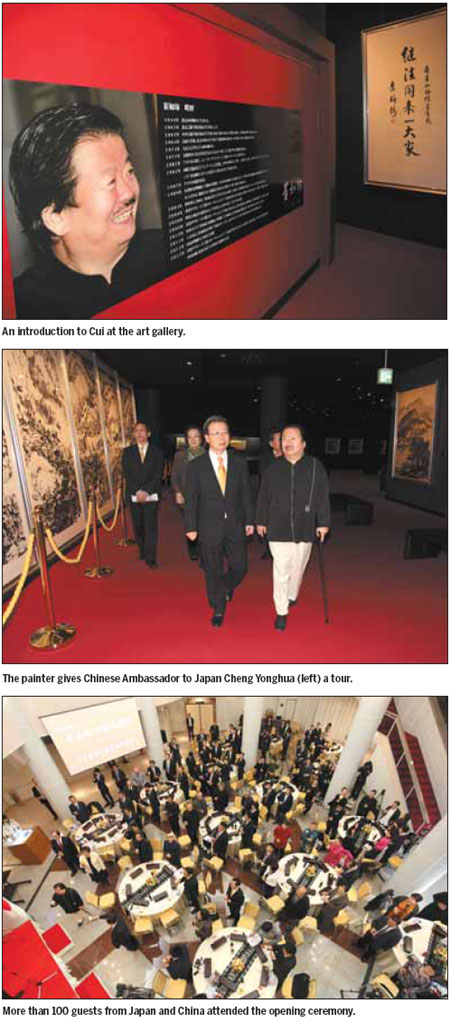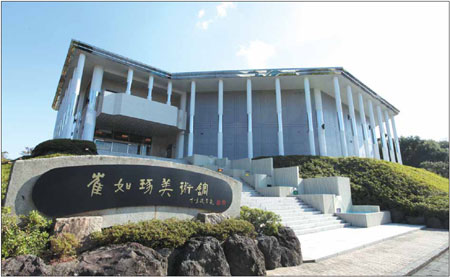Art of friendship
Updated: 2013-12-01 06:51
By Zhuan Ti(China Daily)
|
|||||||||
Famed watercolorist Cui Ruzhuo says his new gallery in Japan serves as a cultural bridge, Zhuan Ti reports
Cui Ruzhuo, a renowned Chinese painter who has visited many parts of the world, says one of his important missions is enhancing international cultural exchanges.
His latest move is the opening of the Cui Ruzhuo Art Gallery in the city of Ito, Japan on Nov 18.
More than 100 guests including the Chinese Ambassador to Japan Cheng Yonghua, Deputy President of the Chinese National Academy of Arts Tian Liming as well as Japanese artists and politicians attended the unveiling ceremony.
Ambassador Cheng delivered a speech at the ceremony, saying that he expects the museum will contribute to strengthened ties between the two countries, especially people-to-people contacts.
Japanese guests attending the ceremony also spoke highly of the artist's achievements.
Shouli Sekiguchi, director-general of the gallery, is one of Cui's best friends in Japan. He said he is deeply impressed by the artist's work and it was his suggestion that Cui open the gallery in Japan.
During the ceremony, Cui outlined what he hopes to accomplish with the gallery.
He said that China and Japan have already built close economic ties, but people usually neglect the need to form deep cultural bonds.
"Painting and calligraphy are both treasures of Chinese culture and can also be a bridge for Sino-Japanese cultural exchange," he said.
For hundreds of years, the cultures of China and Japan have influenced one another.
Cultural exchanges will continue to form an important bond between the two countries in the future, he added.
Born in Beijing in 1944, Cui fell in love with watercolor painting and Chinese calligraphy at a young age.
He settled in the United States in 1981. In 1996, he returned to China and taught at the Central Academy of Fine Arts. Currently, he is a professor at the Chinese National Academy of Arts.
Unlike many Chinese watercolor painters, Cui has traveled around the world, and his works combine the natural stroke of Chinese brushwork with Western aesthetics, making them equally appealing to enthusiasts of fine art in the East and West.
"I hope that through my work Chinese arts can radiate to the West and the artworks can act as a medium to allow the world know more about the Chinese culture," Cui said.
A striking building
Located in Ito city in Japan's Shitsuoka county, Cui's gallery is surrounded by beautiful scenery.
The building is striking, with pure white architecture and pillars that stand in front like guards. A parking lot in the front can accommodate 100 cars.
The gallery is also a compelling tourist destination.
When visitors step into the lobby, the first thing they notice is a large open space that can accommodate weddings, receptions or concerts.
It also has a teahouse for art lovers to enjoy good afternoon tea while appreciating the beautiful landscape outside.
The hall is colored red and black in line with Cui's tastes.
The second floor is the major exhibition area for Cui's artworks.
Unlike the large, cold exhibition halls found in many museums, the second floor also includes human touches such as a restaurant and a lounge.
It is not Cui's first gallery.
In 2007, a Cui Ruzhuo Gallery opened in Beijing displaying more than 100 of his best works. It is one of the largest private art museums in China.
Works and collections
To Cui, art is not only about creating but also about collecting and enjoying the best artworks in history. For decades he has collected ancient paintings and calligraphy created over the past millennium and a half as well as the modern age.
With a profound understanding and sincere love for collecting, Cui has published various books on art theory and collections.
His published works include China Modern Masters' Paintings, World Famous Painters' Works and Cui Ruzhuo Landscape Painting Collection.
Cui's own works have been collected by celebrities from various fields as well as dozens of museums, galleries and universities in the US and Europe.
In China, Cui's works have been repeatedly selected as State gifts to foreign leaders.
Cui's dream even goes beyond art itself. He said he never forgot the underprivileged people in his home country.
After the earthquake in Sichuan in 2008, Cui sold paintings valued at 50 million yuan ($8.2 million) to a Russian company and donated all the proceeds to relief efforts.
Contact the writer at zhuanti@chinadaily.com.cn
|
The gallery in the city of Ito is a striking building with a pure white exterior. Photos Provided to China Daily |


(China Daily 12/01/2013 page8)
